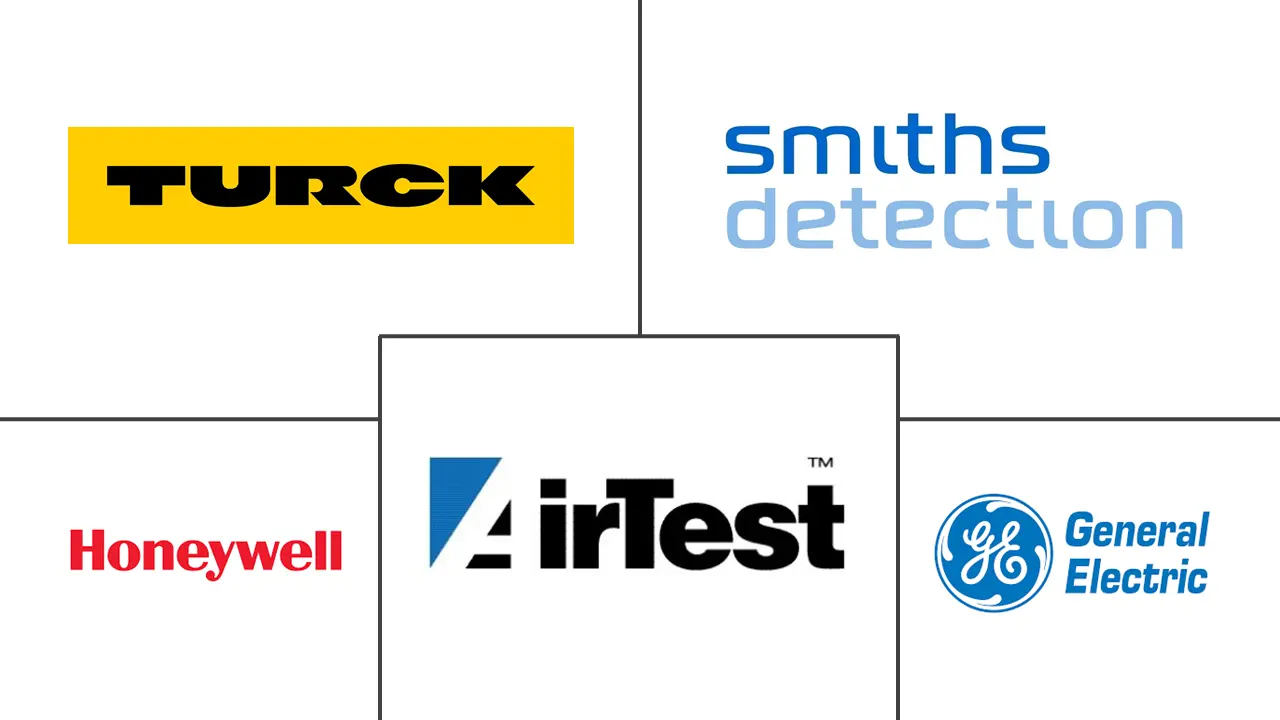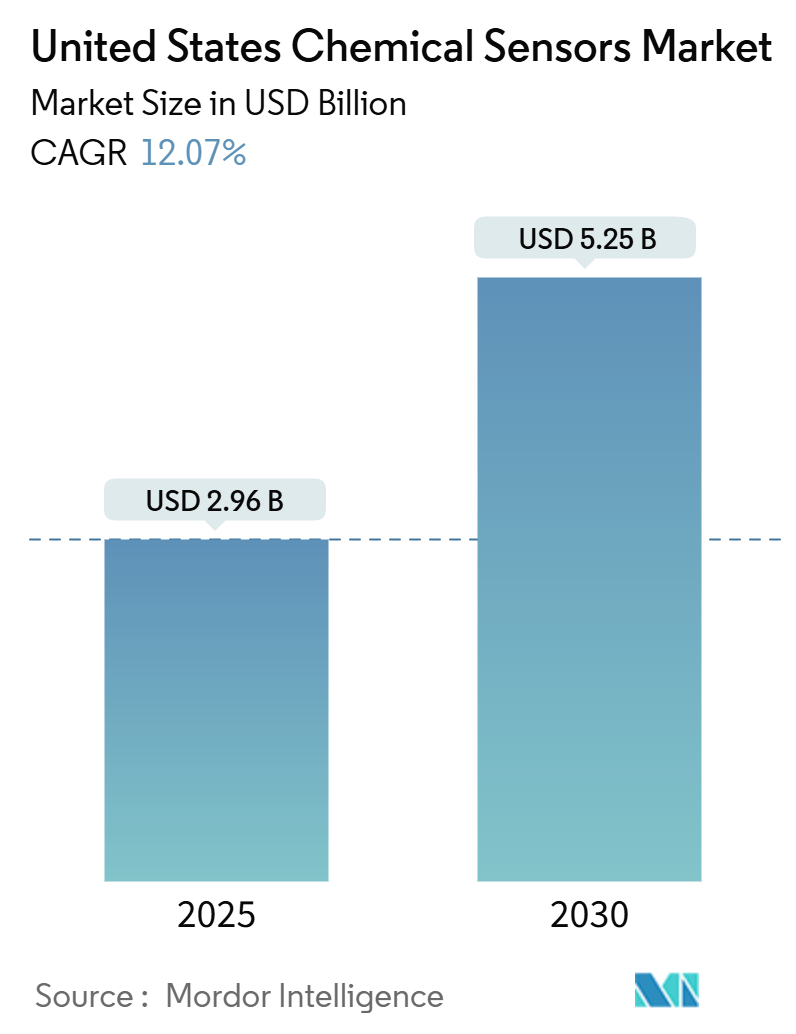
United States Chemical Sensors Market Analysis by Mordor Intelligence
The United States Chemical Sensors Market size is estimated at USD 2.96 billion in 2025, and is expected to reach USD 5.25 billion by 2030, at a CAGR of 12.07% during the forecast period (2025-2030).
- Chemical sensors have evolved technically with the advent of MEMS and nanotechnology. It has been found that with the reduction in size, novel electrical, mechanical, chemical, and catalytic, optical properties can be introduced.
- Various types of detecting elements, such as carbon nanotubes, zinc oxide nanowires, or palladium nanoparticles, have already been used in nanotechnology-based chemical sensors.
- The applications of chemical sensors have witnessed a rise in the medical sector. These sensors are used for the diagnostics of gaseous issues, such as the concentration of chemicals in human bodies. The MEMS sensors have a massive impact on the development of biotechnology, offering researchers the ability to search for and influence chemical and biological compounds in the body and its various complex subsystems. This has led to multiple ways of identifying and preventing illnesses conditions.
- The United States accounts for a significant share. According to the United States Census Bureau, the number of people aged 65 years and above is anticipated to augment from 52 million in 2018 to 95 million by 2060. The share of people of the older age group share is expected to rise from 16% to 23%. Hence, the country is prone to diseases, such as cancer, respiratory diseases, and diabetes.
- Thus, due to rising healthcare expenditure and increasing incidence of diseases, the United States is expected to contribute to the chemical sensors market significantly. Additionally, the government of the United States has introduced mandatory regulations to compel the adoption of CO gas leak detectors in every home.
- Moreover, electronic devices have been impacted significantly by the COVID-19 outbreak and also in post-pandemic scenario, as China is one of the major suppliers of raw materials and finished products. The industry is on the brink of facing a reduction in production, disruption in the supply chain, and price fluctuations. The sales of prominent electronic companies have been affected in post covid scenario.
United States Chemical Sensors Market Trends and Insights
Medical Segment will Witness a Significant Growth
- The biomedical and healthcare sector is one of the significant markets for chemical sensors, primarily owing to the increasing demand for compact, rapid, accurate, and portable diagnostic sensing systems.
- The low cost of raw materials and the advent of nano and microfabrication techniques within the manufacturing process have led to a significant increase in the commercialization of chemical sensors for healthcare applications.
- Abbott Laboratories' revenue of the Medical Devices segment from 2020 to 2023, broken down by category. In 2023, the diabetes care category within this segment was the biggest and generated over USD 5.7 billion. As of 2023, the medical devices segment was the largest segment within the company and generated USD 16.9 billion in revenues.
- Moreover, with the advent of nanotechnology, the operating characteristics of chemical sensors have dramatically changed and are gaining importance in the market. There have been different advances in in-vitro sensors for diagnostics, with a few developments about to be launched shortly. Also, point-of-care diagnostics are possible with chemical nanosensors.
- Molecular point-of-care (POC) diagnostics using electrochemical sensors have gained traction owing to their ability to improve the sensitivity of existing near-patients, perform rapid tests, and expand the diagnostic capabilities at point-of-care, such as physician offices and hospitals critical care units, and outpatient clinics across the world.
- Further, advancements in precise printing and processing technology and next-generation medical and diagnostic electrochemical biosensor product designs in developing implantable glucose sensors for treating diabetes have been developed for intravascular and subcutaneous applications.
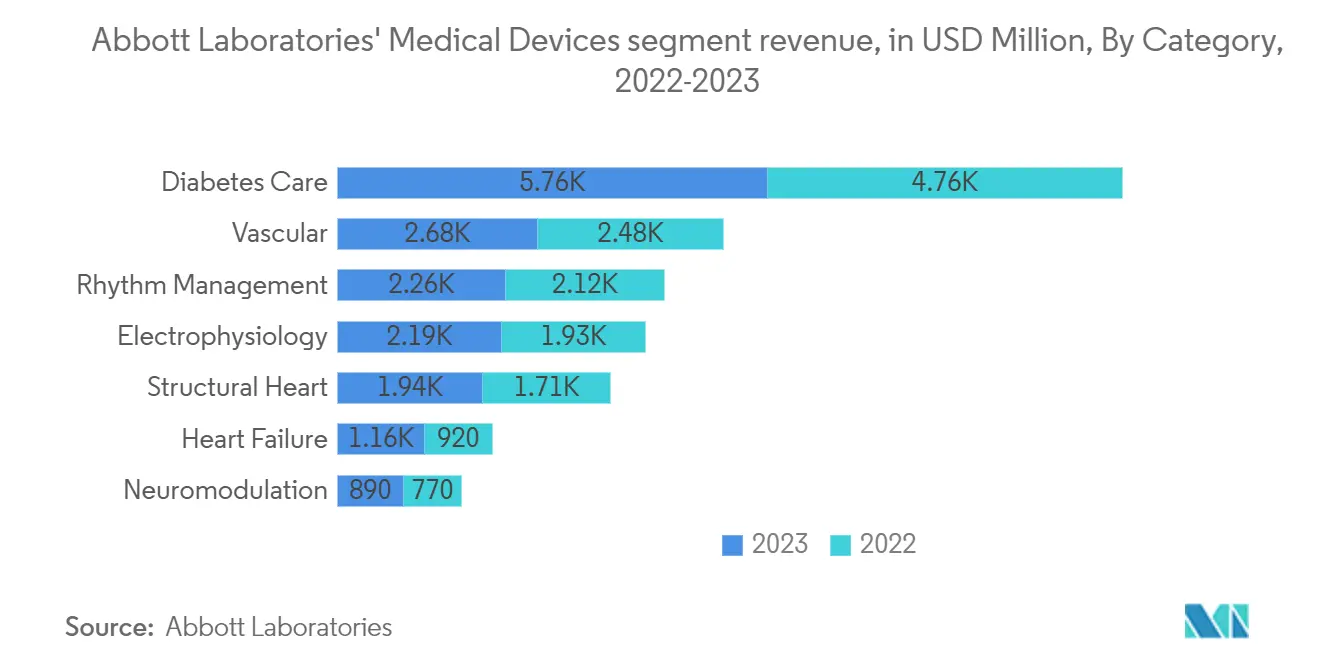
Electrochemical Sensor will Observe Gradual Growth
- Multiplexed POC diagnostics could become a reality due to electrochemical sensors designed to identify specific biomolecules. Electrochemical sensors, such as breathalyzers, respiratory carbon dioxide sensors, and carbon monoxide sensors, are already used to detect harmful gases, oxygen, and other airborne molecules. The chemical oxidation or reduction process occurs when gas hits one of the sensor's electrodes, known as the working electrode, depending on the gas to be examined. For example, when oxygen is reduced to water, electrons flow from the counter (or reference) electrode to the working electrode, resulting in an electric current that can be measured and is proportional to the amount of oxygen in the gas.
- Electrochemical systems are now used in a variety of enterprises across the world. They are frequently used for environmental monitoring and management, as well as other appliances. Electrochemical gas sensors are in high demand for emission control, indoor air quality, fill gas detection with effective multiple gas detection capability, and cost efficiency, to name a few applications. Furthermore, the industry is expected to develop in the approaching years as a result of severe safety standards imposed by various governments.
- Due to an increase in the number of explosions occurring in the extreme environment of the manufacturing and chemical industries due to the presence of toxic and combustible gases, an increased focus on explosion prevention through implicit monitoring across the hazardous zones of these end-user industries has prompted an increased focus on explosion prevention through implicit monitoring across the hazardous zones of these end-user industries to achieve a safer working environment.
- Furthermore, government rules governing offshore oil and gas exploration, production, and storage activities, such as COSHH and OSHA regulations, place rigorous limitations on exposure to carbon monoxide and other dangerous gas emissions. This has been a major driver in the adoption of gas sensors based on electrochemical technology.
- The automotive industry has seen positive growth, owing to new applications such as cabin air quality and fuel emission detectors. A prominent driver for the electrochemical-based gas sensor industry has been aligning trends such as improved fuel efficiency and air quality control.
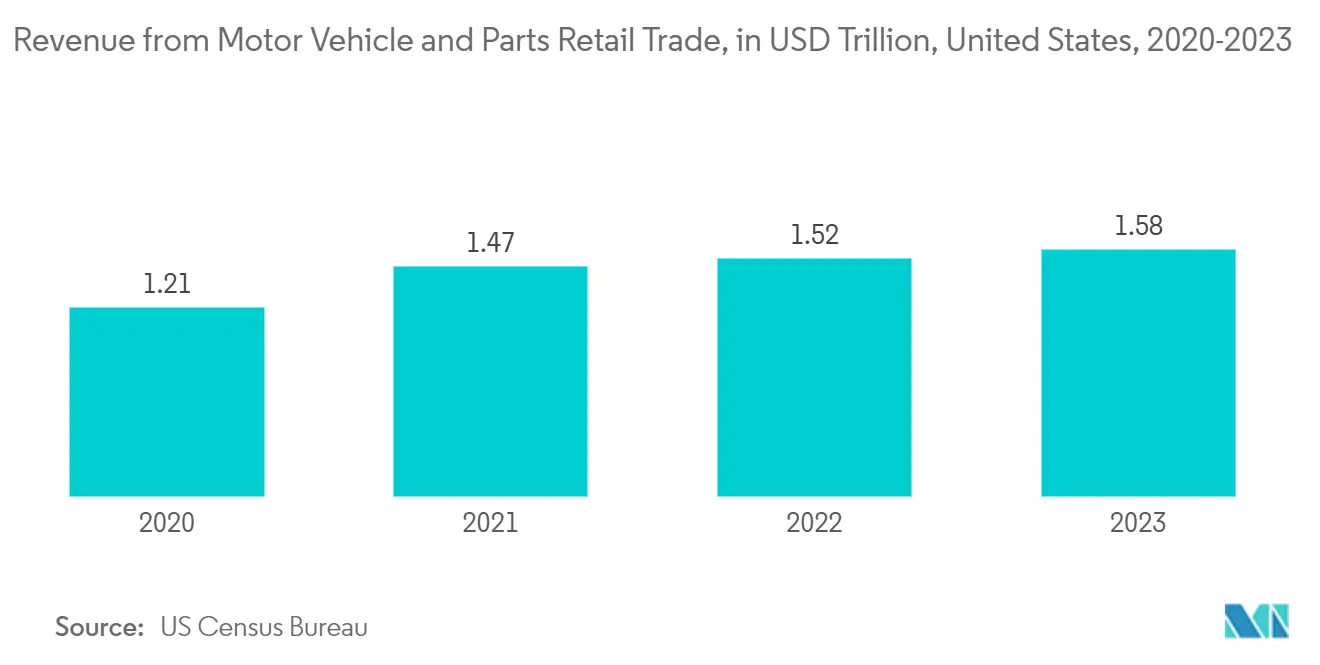
Competitive Landscape
The United States Chemical Sensor market is Moderately Consolidated, with many market players cornering a very minimal share in the market. The development of regional markets and increasing shares of local players in foreign direct investments are the major factors promoting the fragmented nature of the market. Key players in the market are AirTest Technologies Inc., Smiths Detection Inc., and General Electric, and others.
In summary, the U.S. chemical sensors market is on a strong upward trajectory driven by increasing industrial needs, regulatory pressures regarding pollution control, and technological advancements that enhance sensor capabilities across various sectors.
United States Chemical Sensors Industry Leaders
-
AirTest Technologies Inc.
-
Smiths Detection Inc.
-
General Electric
-
Hans Turck GmbH & Co. KG
-
Honeywell International Inc.
- *Disclaimer: Major Players sorted in no particular order
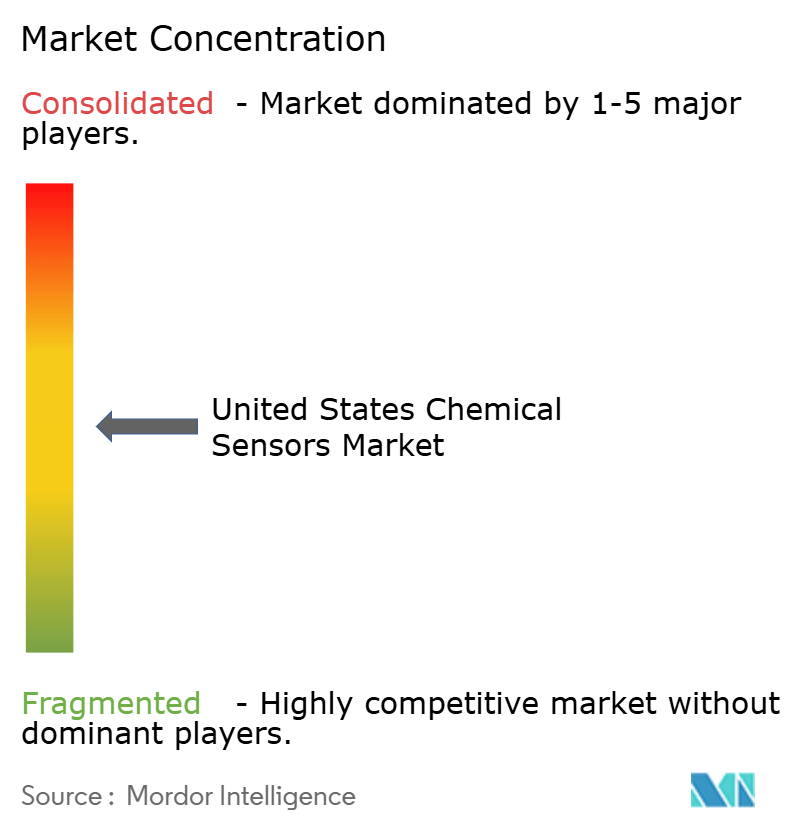
Recent Industry Developments
- April 2024: Yang, team developed new plug-and-play hardware to dramatically enhance sensitivity of optical sensors. These sensors use light to detect changes in properties of the environment they’re monitoring, including chemical biomarkers and physical properties such as temperature.
- February 2024: The U.S. National Science Foundation is investing USD 10.4 million to develop innovative technologies and solutions to address a wide range of challenges related to chemical and biological sensing. Through this investment, 16 multidisciplinary teams have been selected for Phase 1 awards under the NSF Convergence Accelerator's Track L: Real World Chemical Sensing Applications.
United States Chemical Sensors Market Report Scope
Chemical sensors are devices that transform chemical information into an analytically useful signal. These devices are used in sensing and detecting parameters across various industries, including medical diagnosis and treatment, the oil and gas sector, the precision engineering industry, etc.
The United States Chemical Sensor Market is segmented by product type (electrochemical, optical, pallister/catalytic bead) and by application (industrial, medical, environmental monitoring, defense and homeland security). The market sizes and forecasts are provided in terms of value (USD) for all the above segments.
| Electrochemical |
| Optical |
| Pallister/Catalytic Bead |
| Other Product Types |
| Industrial |
| Medical |
| Environmental Monitoring |
| Defense and Homeland Security |
| Other Applications |
| By Product Type | Electrochemical |
| Optical | |
| Pallister/Catalytic Bead | |
| Other Product Types | |
| By Application | Industrial |
| Medical | |
| Environmental Monitoring | |
| Defense and Homeland Security | |
| Other Applications |
Key Questions Answered in the Report
How big is the United States Chemical Sensors Market?
The United States Chemical Sensors Market size is expected to reach USD 2.96 billion in 2025 and grow at a CAGR of 12.07% to reach USD 5.25 billion by 2030.
What is the current United States Chemical Sensors Market size?
In 2025, the United States Chemical Sensors Market size is expected to reach USD 2.96 billion.
Who are the key players in United States Chemical Sensors Market?
AirTest Technologies Inc., Smiths Detection Inc., General Electric, Hans Turck GmbH & Co. KG and Honeywell International Inc. are the major companies operating in the United States Chemical Sensors Market.
What years does this United States Chemical Sensors Market cover, and what was the market size in 2024?
In 2024, the United States Chemical Sensors Market size was estimated at USD 2.60 billion. The report covers the United States Chemical Sensors Market historical market size for years: 2019, 2020, 2021, 2022, 2023 and 2024. The report also forecasts the United States Chemical Sensors Market size for years: 2025, 2026, 2027, 2028, 2029 and 2030.
Page last updated on:
United States Chemical Sensors Market Report
Statistics for the 2025 United States Chemical Sensors market share, size and revenue growth rate, created by Mordor Intelligence™ Industry Reports. United States Chemical Sensors analysis includes a market forecast outlook for 2025 to 2030 and historical overview. Get a sample of this industry analysis as a free report PDF download.
